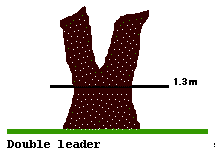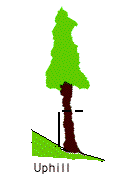
Forest Measurement and Modelling.
 |
Standard point on tree bole for measurement Forest Measurement and Modelling. |
     |
|
|
The size of a tree trunk or bole is of direct relevance to people interested in quantifying the amount of woody material, carbon or biomass in a tree. It is also related to other important tree parameters and may be an index of the quality of a site. Unfortunately measurement of a tree bole is not trivial. The bole is a three dimensional object with a cross sectional area that decreases progressively with height. It is also not a regular shape. Instead, defects and structural anomalies cause bumps and swellings that make measurements difficult. |
|
|
Breast height (reference or standard height on the bole) |
To allow measurements of bole size to be compared, a standard point on the trunk is defined. It is important that this point is at a convenient height near the ground and that it can be reliably located (and relocated) by different measurers. This standard height is termed breast height. The actual location of breast height varies slightly between some countries. In continental Europe, Australia, U.K, Canada and some former members of the British Commonwealth breast height is defined as 1.3 m above the ground. The breast height convention in the USA, New Zealand, Burma, India, Malaysia, South Africa and some other countries is to measure at 1.4 m (or 4' 6") above ground. Breast height is a convention with a long history of use within forestry practice. However, other standard heights are also used. Some researchers in grazing and agriculture use bole size at 0.3 m or 0.7 m above the ground as their standard height. This reference height is used because it has a strong relationship to the grass / crop / tree competition measurements. Researchers studying tree volume have also found very strong relationships between volume and the size of the bole at a relative height (e.g. 5% of the total tree height up from the ground). However, while 5% of a 30 m tall tree is only 1.5 m above the ground and therefore easily within reach, it is difficult to reach the same relative height on a 60 m tall tree. |
| Rules for moving away from the reference height |
Measurement at breast height (or other nominated height) may not always represent the appropriate size of a tree. For example, the volume of the tree bole may not be correlated with a measurement at a height that corresponds to a fork in the tree or a fire scar. Typical causes of unrepresentative points include:
|

|
Special rules apply where a tree forks near breast height. Treat the tree as double or multiple stemmed (i.e. more than one tree) if the fork is below breast height. If the fork is above breast height, treat the tree as a single stem with multiple leaders. When swelling at breast height occurs due to multiple leaders, the breast height measurement is conventionally taken where the bole diameter is smallest below the swelling. Special instructions are also necessary where buttressing and fluting is common. Measurement is commonly made above the influence of the buttress or fluting. Where this influence extends well up the bole, an arbitrary height is specified. When repeat measurements on the bole are expected (e.g. permanent samples), the actual height of measurement should be clearly marked. |
 The representative size of the bole at a nominated height may be estimated by two common techniques:
The representative size of the bole at a nominated height may be estimated by two common techniques:
|
|
Defining ground level
|
Ground level excludes loose leaves and litter that is not incorporated into to soil. Clear it away before taking measurements of height. Consistent definition of ground level on sloping ground or for leaning trees is essential to maintain precision of measurements. Conventionally, ground level on sloping ground is taken to be the uphill of a vertical tree. If a tree is leaning, imagine which would be the uphill side of the tree if the ground was rotated to make the tree vertical. Thus, on level ground, ground level would be defined from the underside of the tree. |

|
[dob.htm] Revision: 6/1999 |